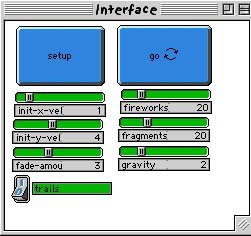
WHAT IS IT? ----------- This program models the action of fireworks. A rocket begins at the bottom of the screen, shoots upwards into the sky and then explodes, emitting a shower of descending sparks. Each rocket, represented by a turtle, is launched upward with an initial x and y velocity. At a certain point in the sky, an explosion occurs, which is represented by a series of turtle hatches. Each hatched turtle inherits the velocity from the original rocket in addition to velocity from the explosion itself. The result is a simulation of a fireworks display. HOW TO USE IT -------------- SETUP sets up the model according to the values indicated by all the sliders and the switch. GO is a forever button that executes the model continually. FIREWORKS creates a random number of fireworks between 0 and the number indicated on the slider. FRAGMENTS determines how many particle fragments will emerge after the explosion of a single firework. GRAVITY determines the gravitational strength in the environment. A larger value will give a greater gravitational acceleration, meaning that particles will be forced to the ground at a faster rate. The inverse is true for smaller values. INIT-X-VEL sets the initial x-velocity of each rocket to a random number between the negative and positive value of the number indicated on the slider. INIT-Y-VEL sets the initial y-velocity of each rocket to a random number between 0 and the number indicated on the slider plus ten. This is to ensure that there is a range of difference in the initial y-velocities of the fireworks. FADE-AMOUNT determines the rate at which the explosion particles fade after the explosiion. TRAILS allows the user to turn the trails left by the explosion particles on or off. In other words, if the TRAILS switch is on 1, then the turtles will leave trails. If it is on 0, then they will not leave trails. If the GO button is stopped and started again after the model begins, all the particles from an explosion explode again. This is because the model is treating each particle as a rocket. Notice also that the particles in the second explosion inherit the velocities from the particles in the first. This model has been constructed so that all changes in the sliders and switches will take effect in the model during execution. So, while the GO button is still down, you can change the values of the sliders and the switch, and you can see these changes being represented on the graphics window. THINGS TO NOTICE ---------------- Experiment with the INIT-X-VEL and INIT-Y-VEL sliders. Observe that at an initial x-velocity of zero, the rockets launch straight upwards. When the initial x-velocity is increased, notice that some rockets make an arc to the left or right in the sky depending on whether the initial x-velocity is negative or positive. With the initial y-velocity, observe that, on a fixed GRAVITY value, the heights of the fireworks are lower on smaller initial y-velocities and higher on larger ones. Also observe that each rocket explodes at a height equal to or a little less than its apex. THINGS TO TRY ------------- Observe what happens to the model when the GRAVITY slider is set to different values. Watch what happens to the model when GRAVITY is set to zero. Can you explain what happens to the fireworks in the model? Can you explain why this phenonmenon occurs? What does this say about the importance of gravity? Now set the GRAVITY slider to its highest value. What is different about the behavior of the fireworks at this setting? What can you conclude about the relationship between gravity and how objects move in space? EXTENDING THE MODEL ------------------- The fireworks represented in this model are only of one basic type. A good way of extending this model would be to create other more complex kinds of fireworks. Some could have multiple explosions, multiple colors, or a specific shape engineered into their design. Notice that this model portrays fireworks in a two-dimensional viewpoint. When we see real fireworks, however, they appear to take a three-dimensional form. Try extending this model by converting its viewpoint from 2D to 3D. StarLogoT FEATURES ----------------- An important aspect of this model is the fact that each particle from an explosion inherits the properties of the original firework. This informational inheritance allows the model to adequately represent the projectile motion of the firework particles since their initial x and y velocities are relative to their parent firework. To visually represent the fading property of the firework particles, this model made use of the turtle command scale-color. As the turtle particles fall to the ground, they hold their pens down and gradually scale their color to black. As mentioned above, the rate of fade CAN be controlled using the FADE-AMOUNT slider.